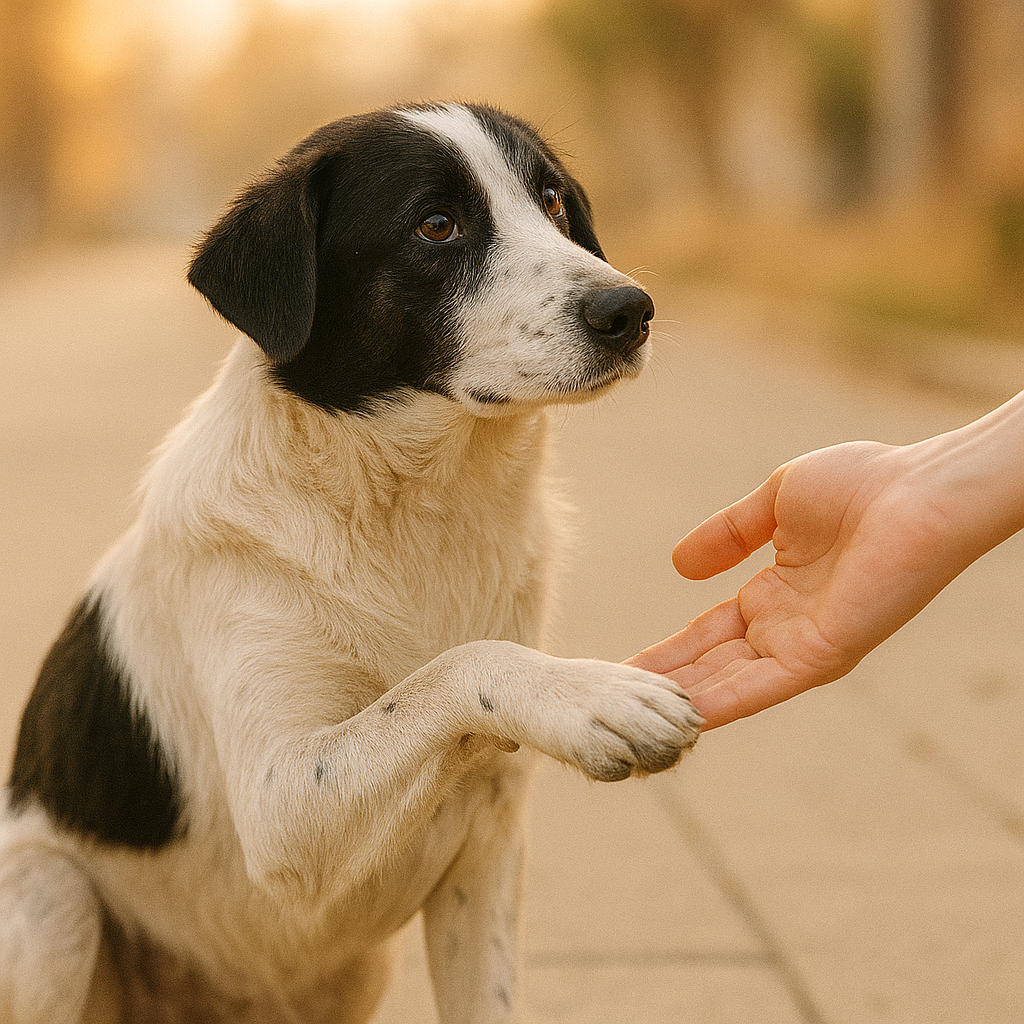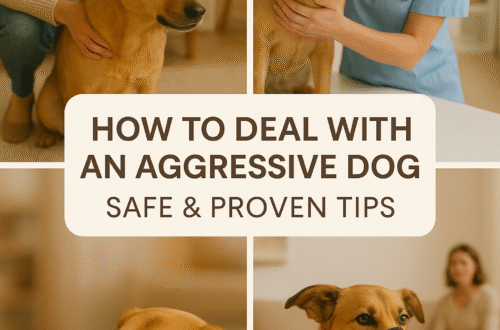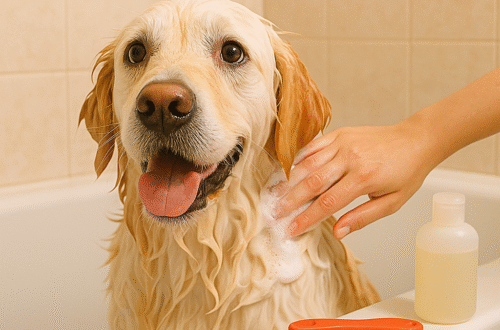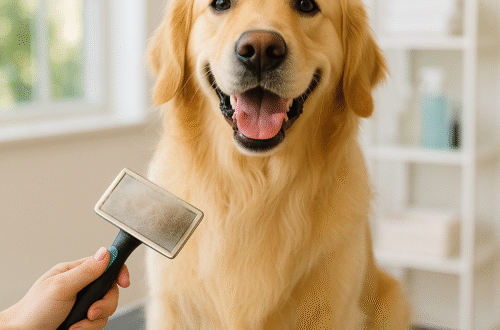You Found a Stray Dog Now What?
You’re walking home, maybe grabbing a coffee or coming back from work when suddenly, you spot a dog wandering the street alone. No collar. No leash. Eyes filled with fear or confusion.
It pauses when it sees you. Your heart aches. What should I do? you ask yourself.
Finding a stray dog can be emotional and overwhelming. You might feel uncertain, but deep down, you know one thing this animal needs help. Whether the dog is lost, abandoned, or homeless, your actions can mean the difference between danger and safety, fear and love.
In this article, you’ll get a clear, step-by-step guide to safely help, care for, and if needed rehome a stray dog, even if you’ve never done this before.

Secure the Area or Call for Help
Once you’ve observed the dog and confirmed it’s not aggressive, the next step is to prevent it from running into danger especially if you’re near a road, park, or crowded area.
Here’s how to safely secure the situation :
- Block escape routes if possible : Without scaring the dog, gently guide it away from traffic or open areas. Use parked cars, fences, or natural boundaries to your advantage.
- Use food as a lure : If you have dog treats, a sandwich, or even some plain chicken or biscuits it can help gain the dog’s trust. Toss a small piece near you to draw it closer gradually.
- Don’t grab the dog suddenly : If it lets you approach, move slowly and kneel sideways (not facing directly). Offer your hand low, palm down.
- Have a leash, rope, or slip lead ready : If the dog is friendly, you may be able to gently slip a leash or soft rope around its neck. Avoid pulling tightly.
- If the dog is not safe to approach call for help : Contact your local animal shelter, animal control, or humane society. You can also reach out to local rescue groups or post in neighborhood social media groups (like Facebook or Nextdoor).
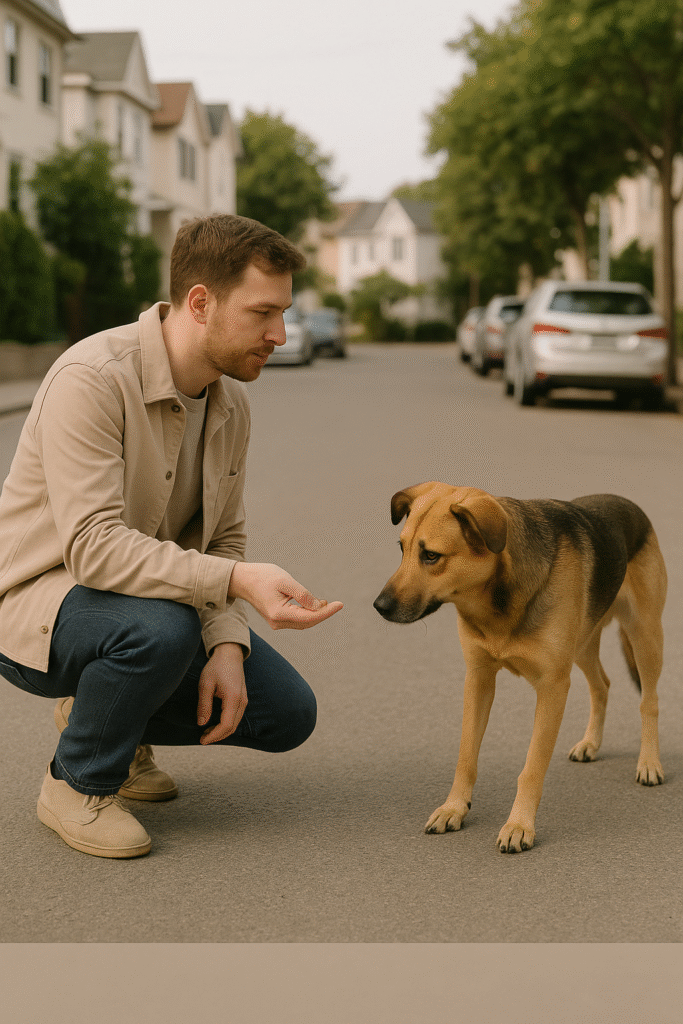
Take Photos and Note the Location
Before moving the dog or heading to a shelter, document everything clearly. This helps if someone is searching for their lost pet or if you need to ask for help online.
What to Do :
- Take clear, close-up photos : Snap pictures from different angles: the dog’s face, body, and any unique features like a spot, scar, or collar. Make sure the lighting is good you want the dog to be clearly visible.
- Capture the surroundings : Include a wide shot showing where you found the dog street signs, landmarks, or intersections. This adds credibility to your lost-and-found post and helps owners verify.
- Note the exact time and location : Use your phone’s GPS or a maps app to mark the location. Write down the time, street, and city area this info is useful for shelters or lost pet sites.
- Observe behavior : Is the dog limping, shivering, or looking for food? These details can help rescues or owners understand the situation better.
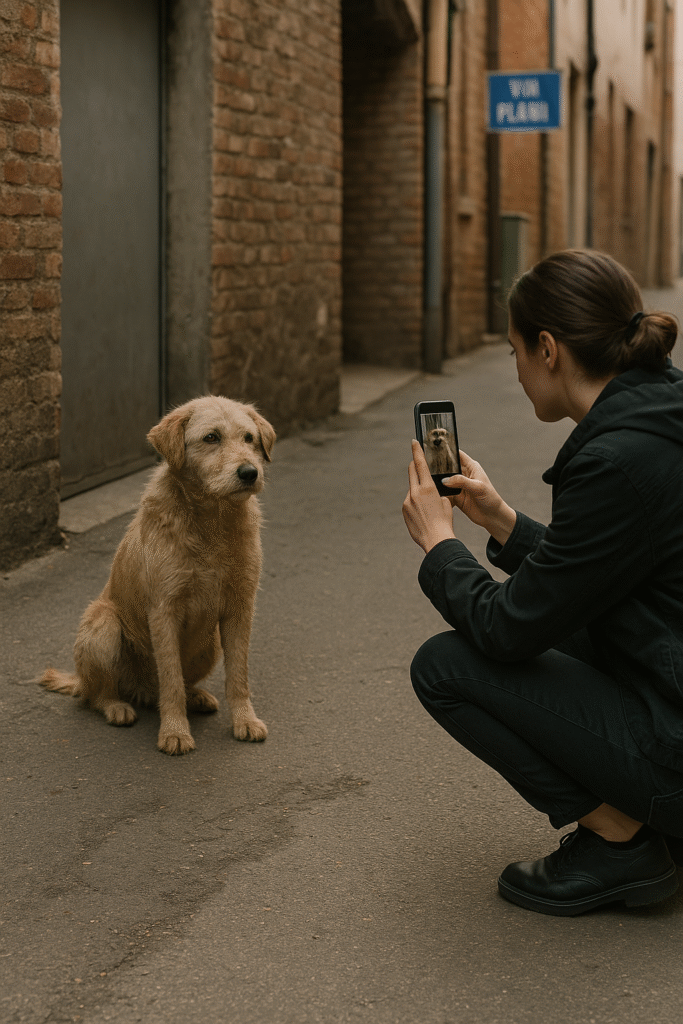
Bring the Dog to Safety
Once the dog is calm and you feel it’s safe to move, the next priority is finding a temporary, secure place where the dog can rest, eat, and stay protected while you figure out the next steps.
Safe Places to Consider :
- Your home (if pet-safe) : If you have no other pets or have a way to keep them separated your home can be a quiet and comforting place for the dog to decompress.
- Garage, fenced yard, or enclosed porch : If you’re unsure how the dog will behave indoors, these are great options. Just make sure there’s no way to escape or get injured.
- Your car (temporarily) : If you’re far from home and the dog is cooperative, the back seat or trunk area (ventilated and shaded) can work as a short-term spot but avoid leaving the dog alone in a hot vehicle.
What to Avoid :
- Don’t bring the dog near young children or other animals until it’s assessed.
- Avoid tying it to poles or leaving it unattended in an open area this increases risk of theft, injury, or more fear.
Tip for Nervous Dogs :
Lay down a towel, blanket, or old shirt especially if it smells like you. It can help calm the dog and give it a sense of safety.
Remember : You’re not expected to have everything perfect just do your best to keep the dog warm, calm, and secure.
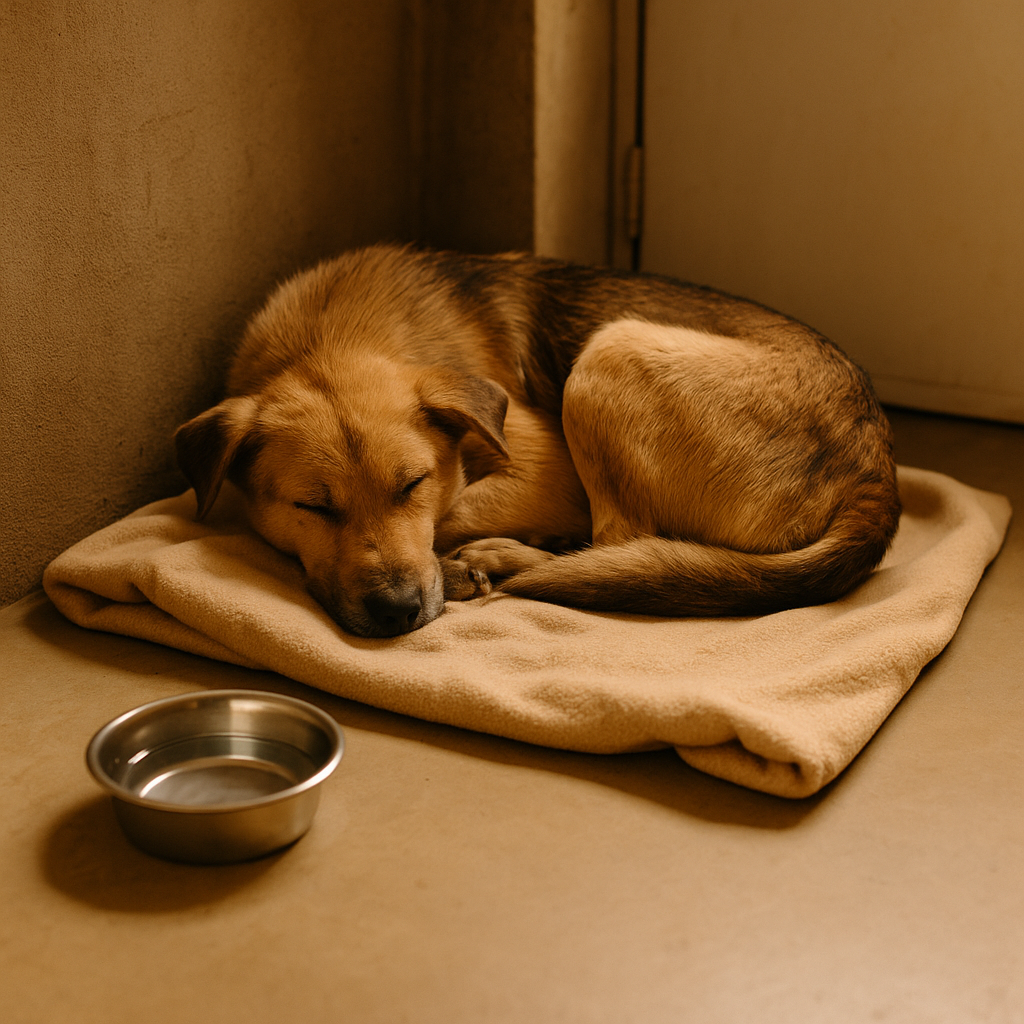
Check for ID Tags or Microchip
Now that the dog is safe, it’s time to find out if someone is missing them and that starts by checking for any form of identification.
Start with a Visual Check :
- Look for a collar and tag : Some dogs have name tags with a phone number or address. If it’s legible, try calling or texting the number right away. Be polite and ask for a description to confirm it’s their dog.
- Check for hidden tattoos or engravings : Occasionally, dogs have IDs etched into their collar buckles, or tattoos on the inner thigh or ear (common with show dogs or dogs from breeders).
Visit a Vet or Animal Shelter :
- Get the dog scanned for a microchip : Most vet clinics and shelters will scan for free. Microchips are small devices under the skin that contain owner contact information.
- No chip? No problem : Many stray dogs aren’t microchipped, so don’t feel discouraged. You’re still doing all the right things.
Be prepared to show the location and time you found the dog, as well as any photos you’ve taken it helps verify your story and speeds up the process.
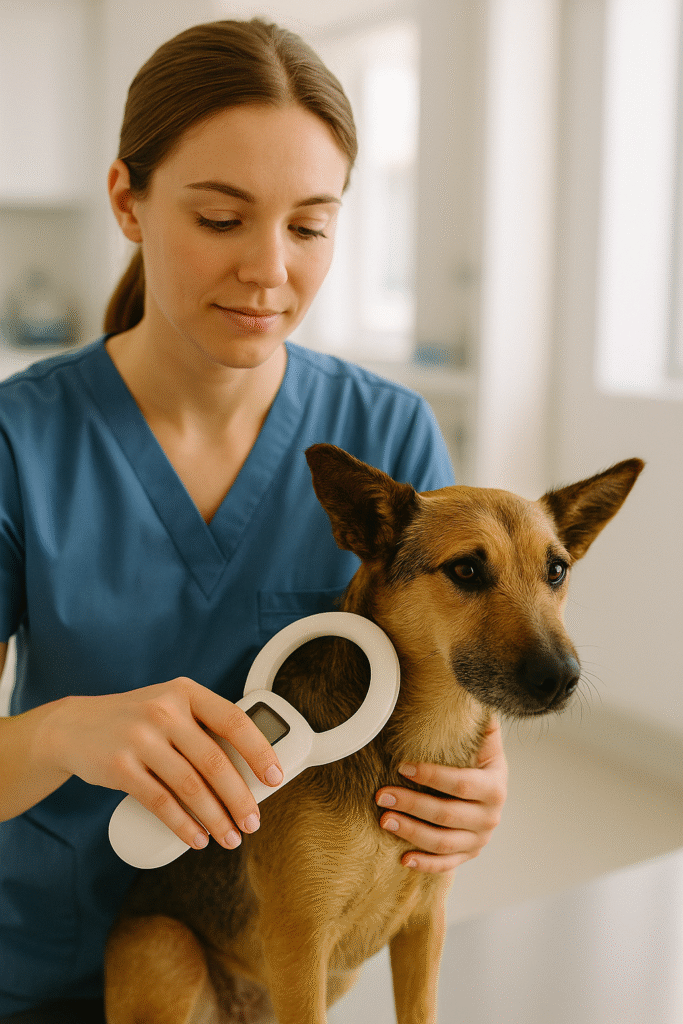
Spread the Word Locally and Online
If the dog doesn’t have a tag or microchip or the owner hasn’t responded the next best move is to let as many people know as possible. You’d be surprised how often a simple post or flyer leads to a reunion.
Where to Post :
- Local Facebook Groups : Search for groups like “[Your City] Lost and Found Pets,” neighborhood watch pages, or animal rescue groups
- Nextdoor App : This neighborhood-based app is great for reaching nearby pet owners fast.
- Local Vet Offices, Groomers & Pet Stores : Print out a flyer and ask to post it on their bulletin boards.
What to Include in Your Post or Flyer :
- Clear photo(s) of the dog
- Basic details: breed (if known), color, size, gender, any visible traits
- Location and time found
- Your contact info (use Google Voice or email if you prefer privacy)
- Optional note like: “No chip or tags. Safe and being cared for.”
Avoid posting too much personal detail about the dog (like a unique scar or collar color) this helps you verify true ownership if someone comes forward.

Care for the Dog Food, Water, and Comfort
Once the dog is safe and the search for an owner is underway, it’s time to make sure the dog is cared for physically and emotionally especially if it’s been living on the streets for a while.
Provide Basic Needs :
- Water first : Many stray dogs are dehydrated. Offer clean, fresh water in a shallow bowl. Let the dog drink at its own pace.
- Feed small portions : If you don’t have dog food on hand, offer plain boiled chicken and rice or canned tuna (in water, no salt). Avoid spicy, salty, or fatty foods like pizza, leftovers, or sweets these can make the dog sick.
- Don’t overfeed : The dog may be hungry, but sudden overeating can cause vomiting or diarrhea. Start with small, bland meals.
Create a Calm Environment :
- Lay out a towel, soft blanket, or old bed for the dog to lie on.
- Keep lights low and noise to a minimum.
- Avoid touching too much in the beginning let the dog come to you when it feels safe.
Watch for Health Issues :
- Look for signs of injury, infection, or illness: limping, shaking, coughing, discharge from eyes or nose.
- If the dog is seriously hurt or unwell, call a vet or local animal rescue. Many offer low-cost or emergency care for stray animals.
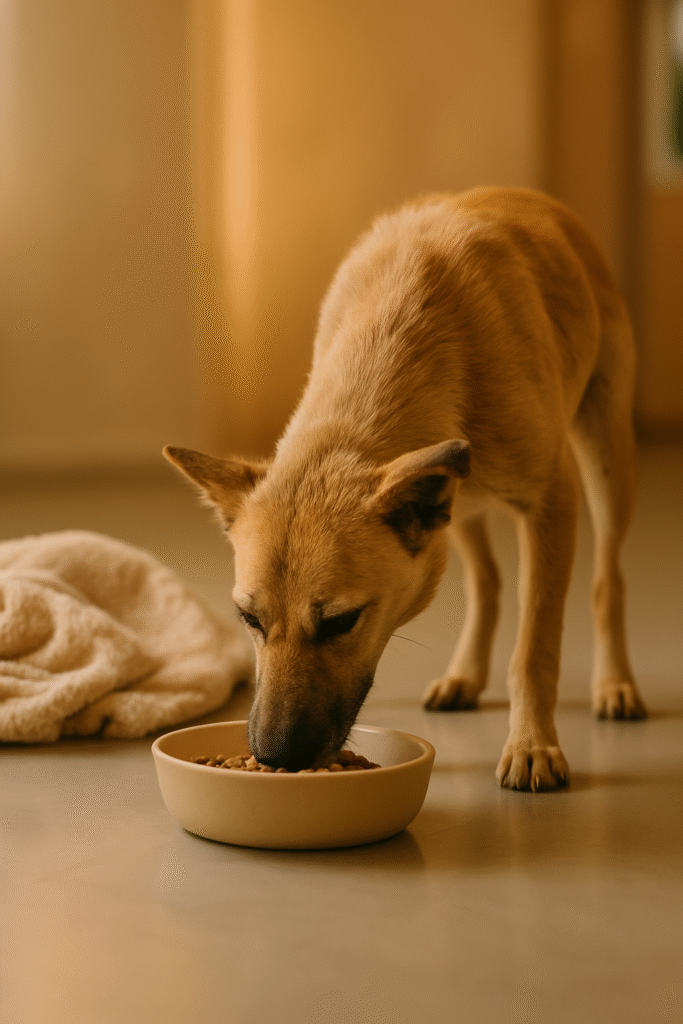
Decide Whether to Rehome, Foster, or Adopt
If no one comes forward after a few days and the dog seems unclaimed, it’s time to think about long-term solutions. This part can feel heavy but remember, you’ve already done more than most by giving this dog a chance.
Know the Waiting Period
Many areas have a “stray hold” law typically 3 to 10 days that gives the original owner time to claim the dog.
- You can check with local shelters or rescues to confirm how long you should wait before rehoming or adopting.
1. Rehome with the Help of a Shelter or Rescue
- Contact local rescue organizations — many can help you screen adopters, list the dog on pet adoption websites, or even take the dog into their foster system.
- Use trusted platforms like:
- Petfinder
- Adopt-a-Pet
- Rescue Me
Avoid giving the dog away for free online Sadly, this puts dogs at risk of neglect or even abuse. Always ask questions and, ideally, use a basic adoption contract.
2. Foster Temporarily
- If you’re not ready to commit, fostering is a great middle ground.
- Some rescues will even cover vet and food costs while you foster.
- This gives the dog a safe space while freeing up shelter space for other animals.
3. Adopt the Dog Yourself
- If you’ve bonded and are willing to commit, adoption may be the best outcome.
- Visit a vet to start vaccines, flea/tick treatment, and a health check.
- Be prepared for a transition period the dog may need time to decompress, learn routines, or socialize.
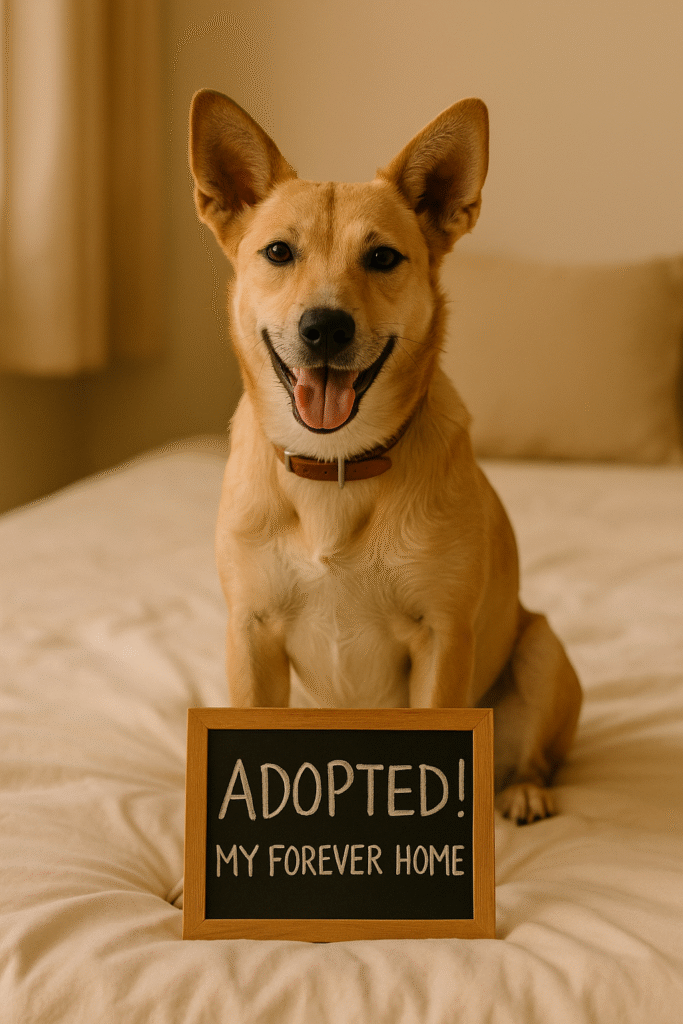
Whatever choice you make, know that you’ve changed a life. Whether it’s through finding the owner, fostering, or adopting your kindness made a huge impact.
